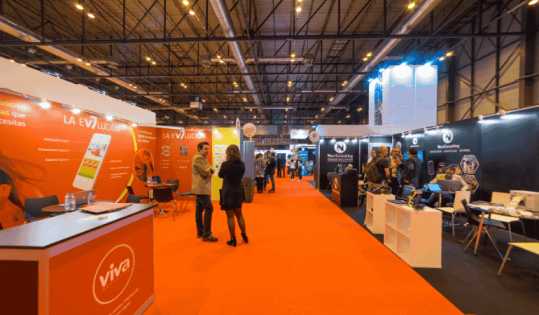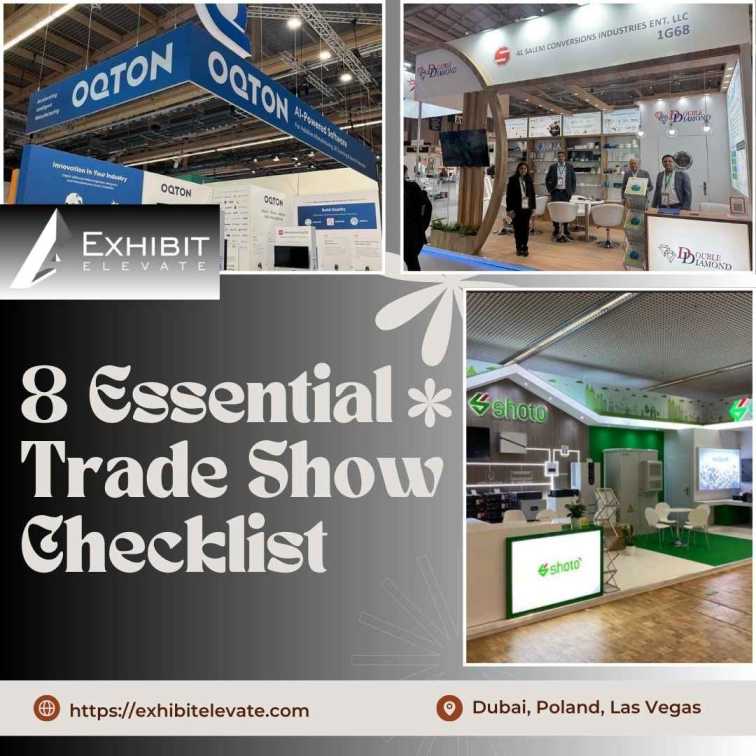One of the best ways for businesses to meet new customers, show off their products, and make their brands more visible is at trade shows. Reports from the business say that there are more than 13,000 trade fairs throughout the world every year, and they draw millions of attendees and decision-makers. Studies suggest that 81% of people who go to trade shows have the power to buy, which means that being at the correct event could lead to important business chances right away.
But you can’t just show up to a trade show and hope for the best; you have to plan ahead. Exhibitors who don’t have a good plan could miss out on up to 40% of prospective leads, spend too much on logistics, or miss important networking chances.
That’s why it’s important to have a trade show checklist that is well-organized. Every little thing is important, from the design of the booth to the training of the workers to the marketing plan and the logistics. A comprehensive step-by-step guide will help you keep organized, prevent costly mistakes, and get the most out of your investment (ROI), whether you’re exhibiting for the first time or have done it many times before.
At Exhibit Elevate, we’ve worked with brands from many different fields and seen how careful planning can turn exhibitions into chances for growth. This post will give you a complete trade show checklist that includes everything you need to do before, during, and after the event to be successful.
Why a Trade Show Checklist Matters
Every little thing matters during trade exhibitions, which are high-stakes events. It can be hard to keep track of everything that has to be done, such getting your booth space, making displays that capture people’s attention, coordinating your personnel, and talking to possible consumers. If you forget about any one part, like marketing, logistics, or getting the team ready, the whole thing could go apart.
A pre-trade show checklist is more than simply a useful tool; it’s a guide to success. A well-thought-out checklist makes sure that everything you need to do is covered, so there is no room for last-minute confusion. It lets you:
- Avoid making expensive blunders that cost you time and money.
- Structured preparation will help you avoid tension at the last minute.
- Show off a professional booth that gets people’s attention.
- Give your employees the tools they need to do their jobs well and with confidence.
- Aligning your efforts with your business goals can help you get the most out of your investment.
Think of it as a survival kit for trade shows that will help you stay organized, focused, and in charge from the time you start organizing until the last day of the event.
Step 1: Define Your Goals and Objectives
Clarity is the first step in any successful trade show journey. If you don’t have a clear goal, your work can become disorganized, and you’ll end up with poor outcomes. First, ask yourself this one simple yet powerful question:
- What is the purpose of this trade show?
- Your answer could change based on what you want to achieve in your business:
- Starting a new product or service and getting people excited about it.
- Getting qualified leads that could become clients in the future.
- Making the brand more visible in a crowded market.
- Taking care of ties with current customers and partners.
If your main goal is to get 200 qualified leads, for instance, your trade show strategy guide should be based on that. You will organize activities to lure people to your booth, create the layout of your display, and educate your personnel. If, on the other hand, your main goal is branding, you might want to spend more on booth design and advertising efforts that make a difference.

Step 2: Making a budget and a plan
A good budget is the most important part of getting ready for a trade show. fees can quickly get out of hand without a well-thought-out budget, especially when unexpected fees come up.
Your checklist for getting ready for a trade exhibition should contain costs in distinct groups, such as:
- Designing and building a booth: You can choose between a custom or modular stand.
- Travel and lodging: Your team’s flights, motels, and food.
- Print materials, web commercials, and campaigns before the show are all ways to market and promote.
- Rent technology and equipment like screens, projectors, tablets, or demo tools.
- Hospitality and gifts include drinks, branded items, or contests to win prizes.
Having a defined plan not only helps you keep track of your money, but it also helps you use your resources wisely. If your main goal is to get leads, for example, you can spend more on interactive displays and lead collection equipment instead of expensive freebies.
Step 3: Design and make the booth
Your booth isn’t just a display; it’s how people see your business during the event. A booth that sticks out can get twice or even three times as many people to come, whereas a poorly constructed one can make your brand go unnoticed.
Every exhibitor should think about these Trade Show Booth Essentials:
- Bold signs and branding: Signs and images that are easy to see and clearly show who you are and what you stand for.
- Strategic lighting: the right amount of light to show off products and make the space feel warm and inviting.
- Interactive displays include screens, demos, VR/AR setups, or touch kiosks that get people involved.
- Comfortable seats or demo areas: places that make people want to talk for extended periods of time.
- Hidden storage is important for keeping personal items, marketing materials, and giveaways organized.
A complete trade show checklist should go beyond design and aesthetics—it must also account for safety regulations, accessibility, and ease of setup. Partnering with experienced professionals like Exhibit Elevate ensures that your booth not only captures attention but also functions seamlessly, complies with industry standards, and remains practical for your team to manage. Most importantly, their expertise helps align every element of the booth with your brand’s overall vision and goals.
Step 4: Advertising Before the Event
One of the worst things exhibitors can do is wait until the event starts to tell people they’re there. The truth is that being successful at a trade show starts long before the doors open. Pre-event marketing is what makes sure that people come looking for you instead of just happening upon your booth.
Your trade show marketing checklist should include the following:
- Social media campaigns: teasers, countdown posts, and getting people to talk about the event using official hashtags.
- Email campaigns: Let people know where your booth is, what your best products are, and what special deals you have.
- Blogs and press releases: Before the performance, get more authority and visibility in your field.
- Personal invitations: Get in touch with VIP clients, partners, and prospects to set up meetings.
- Setting up appointments: Use online forms or calendars to set up conversations with eligible leads ahead of time.
The more buzz you create ahead of time, the more likely people will want to stop by your booth. This proactive approach provides you an edge over your competitors and makes it easier for people to connect with you at the show.
Step 5: Getting Your Team Ready
Your booth may be the main draw, but your crew is what really makes it work. A crew that is well-trained and motivated can turn casual visitors into devoted customers. On the other hand, an unprepared team can ruin even the best-designed booth.
Here’s what to put on your staff’s pre-trade show checklist:
- Consistent brand messaging: Teach your employees how to clearly and confidently explain what makes your business valuable.
- Engagement techniques: Ask open-ended questions instead of yes/no questions to get people talking.
- Lead qualifying skills: Show them how to tell the difference between hot, warm, and cold leads.
- Technology readiness: Make sure everyone learns how to use lead capture tools, applications, or digital devices well.
- Confidence in presenting: Give role-play training to help with short product demos and dealing with criticisms.
The idea is to build a strong team that works together as an extension of your brand. When you prepare your personnel correctly, they will not only represent your company well, but they will also make visitors’ experiences better and increase your trade show ROI.
Step 6: Engage Visitors During the Show
When the doors open for the event, your booth is the center of attention. The true challenge isn’t simply getting people to come; it’s keeping them interested long enough to make a lasting impression. There are a lot of competitors at trade exhibitions, so the most important issue is: How will your booth stand out?
Here are some tips for making your trade fair a success:
- Live demonstrations: One of the best methods to generate trust and interest in your product or service is to see it in action.
- Games and contests: Fun, interactive things like spin-the-wheel, quizzes, or giveaways can keep people coming to your booth.
- Interactive technology: Adding things like touchscreens, VR or AR demos, and digital kiosks not only entertains guests but also teaches them.
- Networking spaces: Comfortable chairs or modest lounge areas make people want to talk for longer and get more involved.
People are more likely to remember your brand long after the event if they have a memorable experience at your booth. It’s not about being flashy; it’s about making an experience that people will remember.
Step 7: Get leads and handle them well
Every trade show has one main goal to get leads. Getting leads isn’t just about getting business cards; it’s about getting useful information that can lead to new business chances in the future.
Here’s how to make your trade show booth checklist better for getting leads:
- Digital tools: Use iPads, QR codes, or lead capture apps to quickly gather and sort information about visitors.
- Segmentation: Sort leads into hot, warm, and cold prospects so you can prioritize follow-up and customize your messages.
- Dedicated roles: Give team members defined jobs to do, like managing leads, to make sure nothing is missed.
Keep in mind that quality is more important than quantity. A smaller number of highly qualified leads often gives you a better return on investment than a big number of unqualified contacts.

Step 8: Follow Up After the Event
A lot of exhibitors think their work is done when the trade show concludes. This is when the most important part of the process starts: following up after the event. Even the finest leads might become cold in only a few days without it.
Add these things to your list of things to do before the trade show:
- Immediate communication: Send personalized thank-you emails within 24–48 hours of the event to demonstrate appreciation and keep the conversation going.
- Sharing content: Share images, videos, and event highlights on social media to keep the buzz going and reach more people.
- Exclusive deals: Offer discounts or promotions solely to people who come to the event to get them to buy right away.
- Follow-ups that are planned: Set up product demos or meetings with hot leads while their interest is still high.
To see how well you did, compare your outcomes to your original goals (like the amount of leads you got, the return on investment, and the visibility of your brand). Then, improve your plans for the next event.
What makes the difference between firms that just “show up” and those that expand over time is a good follow-up plan.
Things to Remember About Balanced Perspectives
Trade exhibitions are a great way to get seen and meet people, but they also take a lot of time, money, and energy. Some companies say that digital marketing gives a faster return on investment with less cost. And it’s true that online campaigns can get results quickly and for less money.
But trade exhibitions have benefits that digital media just can’t match:
- Face-to-face interaction: Building trust and credibility by talking to them in person.
- Live product showcasing: Letting potential customers see, touch, and use your products for themselves.
- Networking in your field: Bringing together peers, partners, and leaders in your field.
- Brand recognition: Standing out in very competitive markets.
Instead of picking one over the other, the greatest thing to do is to combine both. Businesses may get the most out of their trade show marketing by using both digital and physical techniques.
Final Thoughts
Trade fairs aren’t just events; they’re chances to make a lasting impact, get new customers, and get your brand out there. But success doesn’t just happen. It comes from planning, getting ready, and doing things right.
You’ll be ready for every part of the trade show—before, during, and after—thanks to this complete Trade show checklist. Each stage, from getting the booth ready and training the workers to marketing and following up after the show, makes sure you get the most out of your investment.
Companies like Exhibit Elevate can help you stand out with originality, professionalism, and accuracy when it comes to developing booths that make your brand come to life.
The bottom line is that if you plan beforehand, your next trade show won’t just be another event; it will be a great chance for your firm to flourish.



